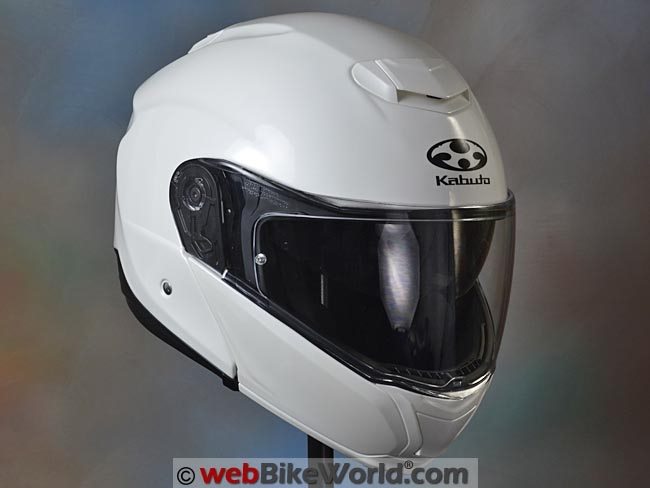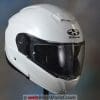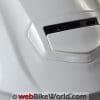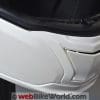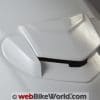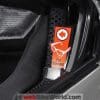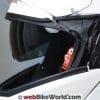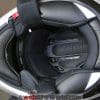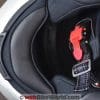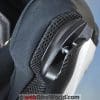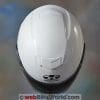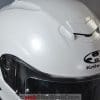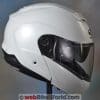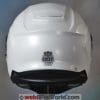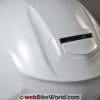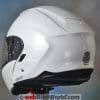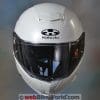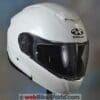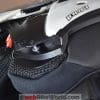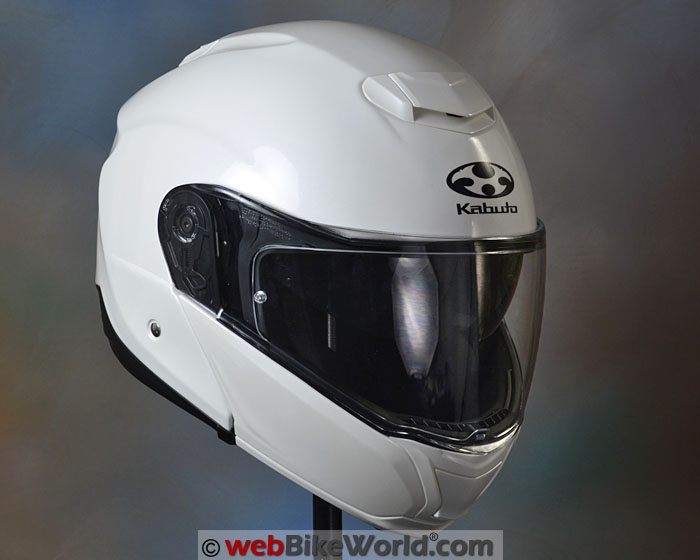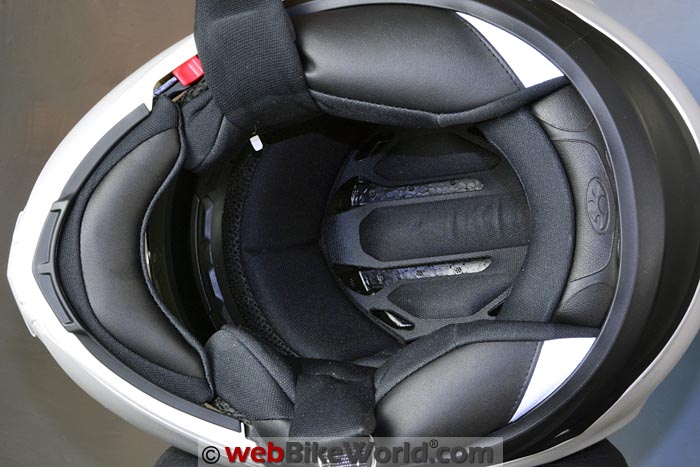The Kabuto Ibuki is a new flip-up helmet recently added to the Japanese company’s expanded lineup.
The styling is “flip-up generic”, designed for owners in this market segment, who tend to be more concerned about function over flash.
The Ibuki’s upper ventilation system is excellent and among the best of the flip-up helmets, which are usually not noted for good ventilation.
Too bad the chin vent isn’t as efficient, however.
The build quality is very good and the interior is thickly padded and very comfortable.
The Ibuki is also relatively quiet, despite the volumes of air flowing through the top with the vents open.
It also comes with a Pinlock insert and a nice chin curtain.
The price does seem a bit stiff though; we originally thought it was in the $250.00 range but it goes for a couple of hundred more than that.
Overall, the Ibuki doesn’t necessarily break any new ground but it does just about everything expected from a solid flip-up helmet.
Without actually planning it, we’ve ended up doing pretty much a review series covering the current Kabuto (formerly OGK) helmet lineup.
So far, we can generally say that Kabuto helmets offer a lot of value for the money; they’re very well built and each has one or more surprise features.
The Kabuto Ibuki (Japanese for “breath”, I’m told) is a new flip-up helmet in the Japanese company’s lineup (although some of the U.S. market Kabuto helmets are now made in China).
It competes in a tough market, with the very popular Nolan N104 (review) and HJC RPHA Max (review) at the same price point and the Nolan N44 (review) and AGV Numo Evo (review) at the lower end.
In fact, the Kabuto Ibuki is very similar in many ways to the HJC RPHA Max and that is very commendable for the company’s first flip-up helmet.
Paint, Graphics and Overall Quality
This Ibuki is the “Pearl White” color and the paint quality is excellent, with no discernable flaws on our example.
It’s finished in a thick-feeling clearcoat, which also covers the “DOT” sticker in the rear and the “Kabuto” decal in the front.
The Ibuki is also available in Matte Black; Metallic Black; Aluminum Silver and Yellow.
The styling isn’t radical by any means; in fact, it’s fairly generic “21st Century flip-up”. But that’s probably a good thing, as flip-up helmet buyers tend to be touring bike riders, favoring perhaps slightly more conservative styling choices.
The helmet shell is “Kabuto’s ACT EVO R composite shell technology” which may be a fancy term for “FRP”, or fiberglass-reinforced plastic, as the label on the inside of the helmet indicates.
The shell feels solid but there’s still some of that flip-up “creaking” sound when you push on the sides.
Overall, the Ibuki is a quality piece, but to be dead honest, without looking at the price, I originally estimated it costing maybe a $250.00. I was surprised to find that the list price is actually $449.95, which does seem a bit stiff to me.
But you’ll also get one of the most comfortable liners going, with thick, comfortable padding that helps deaden the overall noise levels.
You also get a Pinlock insert included in the box — something missing from helmets costing a lot more, like the $550.00 (Ouch!) SCHUBERTH M1 (review).
The moving parts on the Ibuki have a solid feel, but again, there’s nothing exotic or out-of-the-ordinary here.
Score: The Kabuto Ibuki gets an “Excellent” rating for overall finish and quality. See the Summary Table at the bottom of the page for a description of our rating system.
Fit, Sizing and Internal Shape
I’ve been wearing the Ibuki for a few weeks on various rides and I’d say it has a “Neutral” to “Slight Narrow” internal shape, typical for a flip-up helmet and pretty much in line with the majority of motorcycle helmets we’ve reviewed recently.
That type of internal shape fits the vast majority of North American heads, which is why the manufacturers seem to be featuring it in just about every and any new helmet that’s announced.
Think “HJC” fit and you’ll pretty much know what the Ibuki’s internal shape is like, because they’re similar.
This Ibuki is a size large, listed as fitting a 59-60 cm head and I think that’s right on the money, so let’s assume that all of the other Kabuto Ibuki helmets fit to size.
In fact, based on our experience with the “new” Kabuto, the helmets generally have a very comfortable fit and run true to size.
As always, there are no absolutes with helmet fit and shapes. Visit the webBikeWorld Motorcycle Helmet Shapes page for more information.
The Ibuki is made in two shell sizes, with the small shell covering XS-M and the larger shell for the L-2XL range.
Like some of the other recent Kabuto helmets we’ve reviewed, the Ibuki uses the Coolmax liner fabric, which helps keep my head dry in our current 32+ C weather temperatures (90+ F).
The relatively deep ear pockets are nicely lined and the EPS has a 35 mm wide recess for speakers, should you be so inclined.
Don’t forget, speakers work best when they’re located as close as possible to the ears, so you may want to add some spacers under the speakers and most intercom systems have those as part of the kit.

More information on helmet fit can be found in the webBikeWorld Motorcycle Helmet FAQ page, along with the chart that lists the helmet weights of webBikeWorld reviewed helmets and also by shape on the webBikeWorld Motorcycle Helmet Shapes page.
Score: The Kabuto Ibuki gets an “Outstanding” rating for fit, comfort, liner materials and padding.
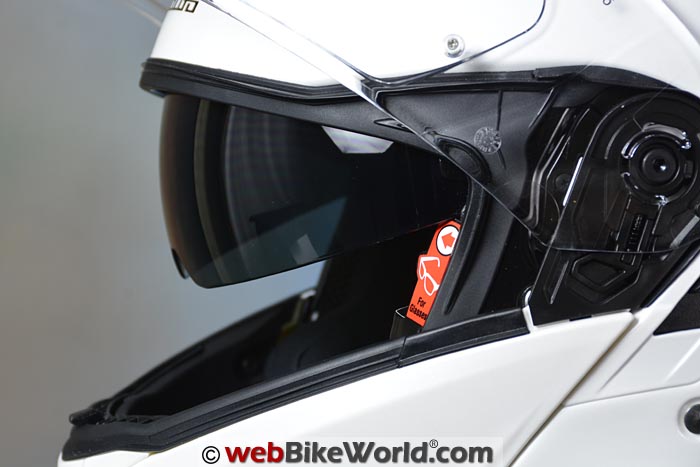
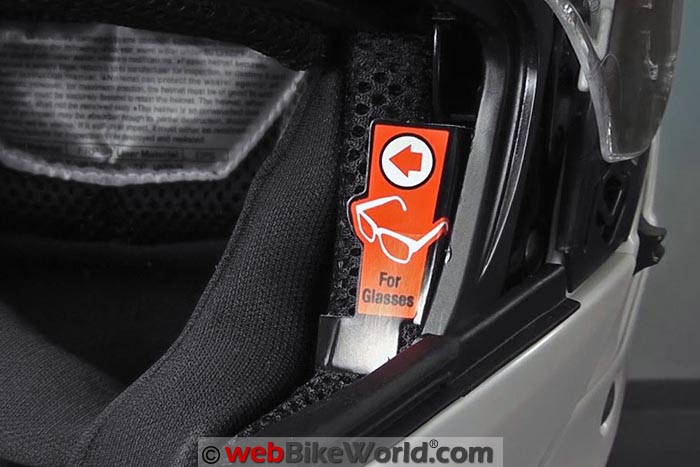
Face Shield, Eye Port and Visibility
Flip-up helmets typically are not trend-setters when it comes to outward visibility. This problem has been exacerbated over the last few years, as we’ve noticed that the chin bar height on flip-up helmets has increased in an attempt at better protection, no doubt.
The taller/higher/wider chin bar doesn’t help visibility, but overall, the view from the Ibuki’s eye port is better than average for a flip-up.
There’s a slight angle at 4 and 8 o’clock that limits visibility slightly, but when the helmet is correctly situated on the head (many riders incorrectly position their helmet tilted slightly rearward), the vertical visibility from the Ibuki, especially when glancing downwards towards the instruments, is good.
The chin bar does seem taller or thicker than the average full-face helmet; again, something found in nearly every recent flip-up helmet.
The quality of the 2.4 mm thick face shield is excellent and it has a friction holding tab at bottom center. The face shield can be opened and then rested on this tab for a bit of city defogging without any noticeable noise increase.
You’ll be using that a lot, because the air flow from the Ibuki’s open chin vent is weak. If you’re riding behind a windscreen, there’s virtually no air flow along the bottom half of the helmet unless you keep the face shield cracked open.
The face shield has a molded outline for the Pinlock insert and the edges of the outline mostly remain out of visual contact.
Also, the thick eye port gasket forms a solid seal, keeping any water from entering the helmet.
The internal sun visor rotates with the slider on the left-hand side. The slider is easy to find and easy to use, but the sun visor could use about another 15 mm of travel to make it more effective.
The Ibuki face shield removal system is easy to use. Pull down on a release and three plastic tabs hold the face shield in place. Carefully pull to remove the face shield and then line up the tabs to replace it, carefully pushing them back in.
Rotating Flip-up Visor
The rotating flip-up visor has a strong detent when it’s raised to the upper position. This holds the rotating flip-up visor in place when you’re refueling or talking.
As always, unless the helmet is dual homologated, don’t ride with it in the raised position…
The Ibuki has a single release for the rotating flip-up visor; it’s a lever on the left-hand side. It can be difficult to find, especially when wearing gloves and I’d rather have a centrally-located release.
The visor clamps or “jaws” that lock the rotating flip-up visor closed are half plastic and half metal. They clamp around a metal post. The system isn’t the most solid-feeling I have tried, with some fore/aft play and lateral flexibility.
Overall the system feels and operates about average for a flip-up helmet, but more like a helmet in the sub-$250.00 class.

Score: The Kabuto Ibuki gets an “Excellent” rating for the overall quality and operation of the face shield.
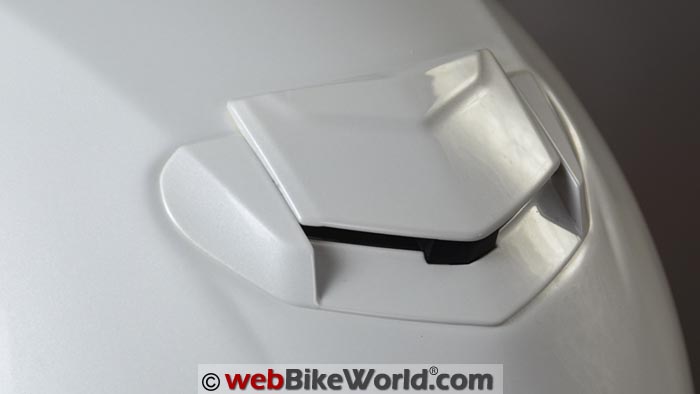
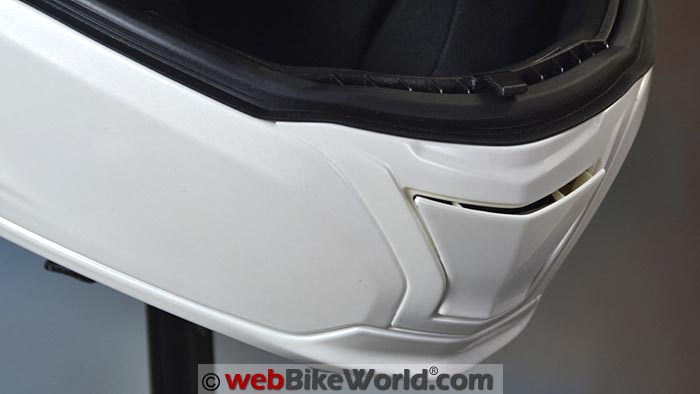
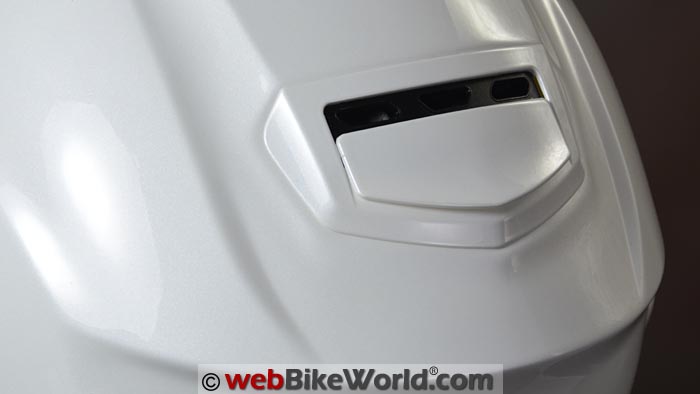
Ventilation
Ventilation in the Ibuki helmet is something of a paradox. The upper half of the helmet has excellent ventilation with air flow that is much better than the average flip-up. But the lower half of the helmet is disappointing.
The upper ventilation system consists of two large horizontal vents, an intake in front and exhaust in the rear. Inside the helmet are large intake ports and channels in the EPS that are open and not blocked by liner material.
As we’ve noted before, those two ingredients are crucial to a successful upper ventilation system. But, they don’t necessarily guarantee performance.
In the Ibuki however, it works. The large vent in front brings in a lot of air, which flows along the channels and out the exhaust, which is placed closer to the top of the helmet than usual.
Open both vents and the air can positively be felt along the top of the head. Close the vents and it stops.
In either case, noise levels are relatively low; surprisingly so when the vents are open, considering the amount of air that comes through.
So far, so good…
The chin vent is another story. Style won out over function here, because the chin vent is of the type favored by manufacturers like Schuberth.
The vertical vent cover is a rocker that is pressed on the bottom to open a small slit at the top. This means the air has to travel up and over the open vent rather than a straight shot into a “scoop” type vent opening.
That slot is just 2 millimeters wide on the Ibuki — maybe 3 mm, depending on how you hold the scale.
Compound that with the fact that there are no open vent passages through the chin bar itself. The air can only enter through the narrow slit along the top of the chin bar.
All of this means that the lower half of the Ibuki barely gets any air, although as is almost always the case, some air manages to (thankfully) flow in from underneath the helmet, despite the nice and large chin curtain.
Had Kabuto designed the chin vent cover as a “scoop” or somehow designed it to allow more air into and through the chin bar, we’d probably have one of the best ventilated motorcycle helmets of any type.
The weak air flow through the chin vent is especially noticeable when riding behind a windscreen. I can feel the nice, cool air over the top of my head while the bottom half of my face is hot and sweaty, especially noticeable because of the large and tall chin bar.
At least the ability to rest the face shield on the friction holding tab helps, although there still isn’t much air coming in if you’re riding behind a windscreen.
On an unfaired motorcycle, it’s not as bad. With the face shield in the city defogging resting position, a good amount of air flows into the helmet, although you won’t have the locking or holding ability available once you get up to speed.
Also on the unfaired bike, some air does flow in through the top of the chin vent and thus along the top of the chin bar. If your head is tiltled forward, this improves slightly.
Overall, the Ibuki ventilation system is a paradox, with excellent upper ventilation not matched by the design of the chin vent.



Score: The Kabuto Ibuki ventilation system rates a “Very Good” overall.
Kabuto Ibuki Noise Control
Noise is well controlled in the Ibuki, mostly due to the thick and comfortable padding that also forms a snug seal around the bottom of the helmet (dependent upon a correct match between the rider’s head shape and the internal shape of the helmet).
Even with the top vents open, the noise is muted, which is a pleasant surprise.
As always, noise perception can vary quite dramatically and is affected by several factors, including a windscreen that directs air and/or buffeting along the top of the helmet.
The helmet shape isn’t quite like a “hot knife through butter” when riding and there does seem to be some push when my head turns side-to-side or in cross wind situations, but nothing unusual for a touring helmet.
Overall, I’ll rate the Ibuki as better than average for noise control for a flip-up helmet.



Note that our helmet evaluations are a combined effort of several riders over time on different types of motorcycles with and without windscreens.
Evaluators wear correctly fitted, high quality ear plugs (even when evaluating motorcycle intercom systems).
Always protect your hearing when riding a motorcycle. See the wBW Earplug Reviews for more information on choosing and wearing earplugs.
Note also that perceived noise levels will vary, depending on the individual.
Noise can be caused by many factors, including helmet fit, the type of motorcycle and windscreen, wind speed and direction and even the rider’s clothing.
For more information on helmet noise, visit the wBW Motorcycle Helmet Noise page.
Score: The Kabuto Ibuki rates an “Excellent” rating for noise control.
Helmet Weight
This Kabuto Ibuki in size L (59-60 cm) weighs 1771 grams (3 lbs., 14-1/2 oz.). Kabuto touts the light weight of the Ibuki but the helmet doesn’t seem so and in fact the weight is about average for this type of helmet.
As always, the internal sun visor accounts for some of the weight and that’s one of the tradeoffs (along with the space it takes in the forehead of the helmet shell).
Other flip-up helmets in size large that are competitors include the Nolan N104 (review) and theHJC Sy-Max III (review) at 1778 grams.
Also the Nolan N90 (review) a weighs 1784 grams; the Shoei Neotec (review) at 1812 grams and the Caberg Sintesi 2 (review) at 1772 grams.
Note also that all of the helmets reviewed on webBikeWorld have been weighed and the weights are available on the wBW Motorcycle Helmet Weights page, along with a chart that lists the helmets by weight and shape on the wBW Motorcycle Helmet Shapes page.
Score: The Ibuki gets a “Very Good” rating for its weight and balance.
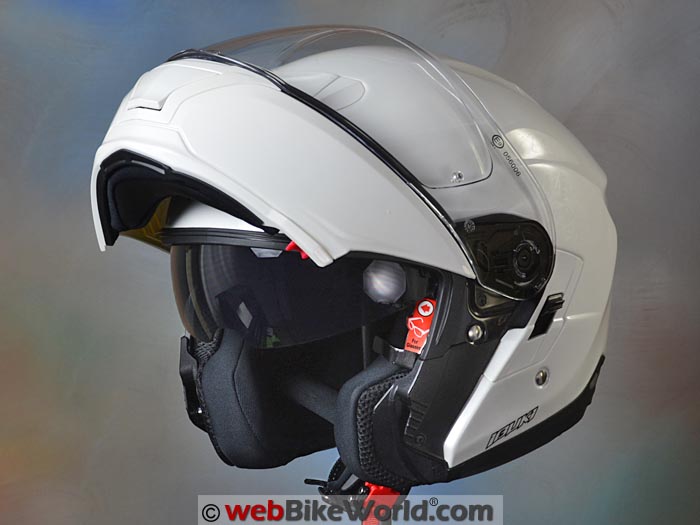


Miscellaneous
The Ibuki has a rather large quick release chin strap retainer. A lighter, simpler and proven double D-ring type is preferred. The chin strap has a metal D-ring for locking via a cable to the bike. The chin strap padding is generous.
The helmet is labeled as meeting both DOT and ECE safety standards.
- Excellent quality.
- Comfortable fit.
- Relatively quiet.
- Excellent upper ventilation.
- Water sealing.
- Weak lower ventilation.
- Price seems high.
Conclusion
The Kabuto Ibuki is a genuinely nice flip-up helmet with remarkably good design and execution considering it’s the company’s first flip-up helmet.
The upper ventilation is notable by its excellence and the interior is also plush and comfortable and provides a relatively quiet riding environment.
There isn’t an over-abundance of excitement here, but that’s not necessarily a bad thing in this segment.
I can’t help but think that the price seems a bit high though for what you get, when compared to what is probably the class leader in this price range, the Nolan N104.
At $449.95, the Ibuki just doesn’t seem to have the same value as the other Kabuto helmets we’ve reviewed and it’s apparently not currently being discounted.
It’s going to be difficult to beat the current mid-range flip-up helmet champ, the made-in-Italy Nolan N104, which can be found for around $405.00 street price. But we’ll see!
Owner Comments and Feedback
See details on submitting comments.
From “B.G.” (August 2015): “”I wanted very much to like this helmet. It fit me perfectly, and I believe I’m a “difficult” fit, with a long narrow shape head.
I have an Arai Signet-Q, and I loved the fit of the Ibuki.
The deal breaker for me was the chin strap buckle. That comment about “…rather large quick release chin strap retainer” in the Misc section of the review is very accurate.
That stupid thing wanted to choke me when I put my chin to my chest.
Too bad, I would have paid the steep fare for a good helmet that fit me well. I prefer double D rings for this reason. No sale this time.”


